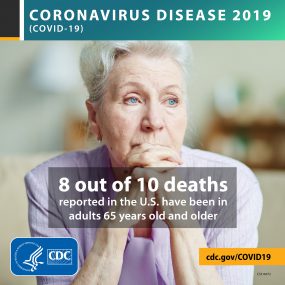Older Adults are at Greater Risk for COVID-19
Older adults, 65 years and older, are at higher risk for COVID-19 and other severe illnesses. COVID-19 is a new disease and we are learning more about it every day.
What you can do to Reduce Risk of COVID-19?
If you have a serious underlying medical condition:
- Stay home if possible.
- Wash your hands often.
- Avoid touching your eyes, nose, and mouth with unwashed hands.
- Avoid close contact (6 feet, which is about two arm lengths) with people who are sick.
- Clean and disinfect frequently touched surfaces.
- Avoid all cruise travel and non-essential air travel.
- Call your healthcare professional if you have concerns about COVID-19 and your underlying condition or if you are sick.
Know how it spreads
- There is currently no vaccine to prevent coronavirus disease 2019 (COVID-19).
- The best way to prevent illness is to avoid being exposed to this virus.
- The virus is thought to spread mainly from person-to-person.
- Between people who are in close contact with one another (within about 6 feet).
- Through respiratory droplets produced when an infected person coughs, sneezes or talks.
- These droplets can land in the mouths or noses of people who are nearby or possibly be inhaled into the lungs.
- Some recent studies have suggested that COVID-19 may be spread by people who are not showing symptoms.
For more information on steps you can take to protect yourself from the risk of COVID-19, see the CDC’s article on How to Protect Yourself and Others.
8 out of 10 COVID-19 Deaths Reported in the US Have Been in Adults 65 Years Old and Older

Among adults with confirmed COVID-19 reported in the U.S.:
- Estimated percent requiring hospitalization
- 31-70% of adults 85 years old and older
- 31-59% of adults 65-84 years old
- Estimated percent requiring admission to intensive care unit
- 6-29% of adults 85 years old and older
- 11-31% of adults 65-84 years old
- Estimated percent who died
- 10-27% of adults 85 years old and older
- 4-11% of adults 65-84 years old
What You Can Do to Protect Yourself from COVID-19?
If you are at higher risk of getting very sick from COVID-19, you should
- Stock up on supplies
- Take everyday precautions to keep space between yourself and others
- When you go out in public, keep away from others who are sickL
- Limit close contact and wash your hands often
- Avoid crowds, cruise travel, and non-essential travel
- If there is an outbreak in your community, stay home as much as possible
- Watch for symptoms and emergency signs
- If you get sick, stay home and call your doctor
More information on factors that can help protect you from getting very sick from COVID-19 is available on the CDC’s Factors That Affect Your Risk of Getting Very Sick from COVID-19 web page.
Should I Wear a Facemask to Protect Myself from COVID-19?
UPDATE: 12 May 2020. Yes, CDC now recommends wearing cloth face coverings in public settings where other social distancing measures are difficult to maintain (e.g., grocery stores and pharmacies) especially in areas of significant community-based transmission.
It is critical to emphasize that maintaining 6-feet social distancing remains important to slowing the spread of the virus. CDC is additionally advising the use of simple cloth face coverings to slow the spread of the virus and help people who may have the virus and do not know it from transmitting it to others. Cloth face coverings fashioned from household items or made at home from common materials at low cost can be used as an additional, voluntary public health measure.
The cloth face coverings recommended are not surgical masks nor N-95 respirators. Those are critical supplies that must continue to be reserved for healthcare workers and other medical first responders, as recommended by current CDC guidance.
Information for this article has been taken from the Center for Disease Control (CDC). More information about COVID-19 (coronavirus) is available at the Center for Disease Control website.
